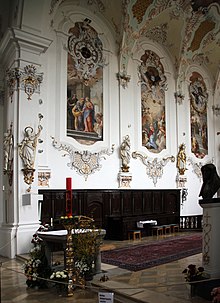St. Mary's Assumption (Schongau)
The Catholic parish church of St. Mary of the Assumption is an originally Gothic, Baroque wall pillar church in Schongau in the Weilheim-Schongau district in Upper Bavaria . It belongs to the parish community of Schongau in the diocese of Augsburg and shapes the cityscape of Schongau.
history
The Church of the Assumption of Mary is the oldest church in the city of Schongau and is mentioned for the first time in the documents of the Rottenbuch monastery in 1253. The first church building was probably a three-aisled Romanesque basilica from the 13th century, which can be deduced from the remains of the foundations in the northern area. The eastern parts were apparently rebuilt in the 15th century; Remnants of this Gothic complex are still preserved in the choir and tower. The choir vault was rebuilt in 1667 after the tower collapsed. The nave was rebuilt in the years 1751–1753, the plan for it is attributed to the Munich court builder Johann Baptist Gunetzrhainer , the execution was supervised by the lower court builder Johann Bauer and the master mason Lorenz Sappel. The church, consecrated in 1754, was renovated on the outside in 1973 and on the inside in 1999–2002 while reconstructing the original version from 1761.
architecture
The church is a pillar church with a slightly lower, recessed, three-sided closing choir. The tower with an octagonal top and a Welsch dome connects to the north side of the choir. The choir and the nave are closed with barrel vaults with stitch caps , the side chapels with transverse barrels. The wall is divided by corinthian pilasters with strongly profiled entablature. The stucco in the choir was made in 1748 by the builder of the Wieskirche , Dominikus Zimmermann , in the nave in 1753 by Jakob Stiller from Wessobrunn .
The ceiling paintings were created by Matthäus Günther . The painting in the choir depicts Mary as the bride of the Holy Spirit and was created in 1748. The representation of the Holy Spirit in human form is striking; a representation that had already been banned by Pope Benedict XIV in 1745 . In the ceiling painting of the nave from 1761 a Coronation of the Virgin is shown, including Esther before Ahasver as a typological model . From the heart of Mary a broad beam leads to an allegorical representation of the city of Schongau as a woman with a flaming heart. On the north wall of the choir there are three paintings by the local painter Franz Anton Wassermann from 1757, which show the temple passage, the Annunciation and the Visitation of Mary. A clock is integrated into the western painting, which is controlled by the tower clock.
Furnishing
The high altar over an oval floor plan was created in the years 1758–1760 by Franz Xaver Schmädl from Weilheim in a free variation of a design by Franz Ignaz Günther and shows a plastic representation of the Assumption of Mary. The sculptures were created by Schmädl, the central figure of Immaculata from the first third of the 17th century was attributed to Bartholomäus Steinle . The rosary saints Dominic and Catherine of Siena are depicted at the feet of the Immaculata, the Holy Trinity in the altar extract and the knight saints Mauritius and Martin above the side passages .
The sculptures of Jesus, Mary and the twelve apostles on the choir walls and the pair of western wall pillars were created by Johann Pöllandt in 1698 . The altar leaves on the side altars were painted by Franz Anton Wassermann around 1750. On the altars of the north side chapels you can find St. Anthony of Padua with St. Michael in the excerpt and the Holy Tribe with St. George in the excerpt. On the corresponding altars of the southern side chapels, you can find the Holy Walk with a depiction of St. Vitus in the extract and St. Sebastian with St. Rochus in the extract.
A table altar from the 13th century has been preserved, which has been erected on the choir step since 1997 and previously stood in the cemetery chapel of St. Michael, which no longer exists, and later in the crypt of the Holy Cross Chapel. Opposite the pulpit hangs a late Gothic crucifix.
The tombstone of the dean and builder of the church Johann Georg Jäncker († 1771) is placed above the southern holy water font. Under the organ gallery there are sculptures of Saints Sylvester and Ulrich from around 1500 on the side of an oil painting by Nikolaus Augner from 1811 with a representation of Saint Florian with a view of the city of Schongau. The organ in a prospectus with late baroque shapes is a work by Orgelbau Sandtner from 2012 with 43 stops on three manuals and pedal .
literature
- Georg Dehio : Handbook of the German art monuments. Bayern IV: Munich and Upper Bavaria. Deutscher Kunstverlag, Munich, Berlin 2006, ISBN 978-3-422-03115-9 , pp. 1186–1187.
Web links
Individual evidence
- ↑ Information on the history on the website of the Schongau parish community. Retrieved October 1, 2018 .
- ↑ Information about the organ on orgbase.nl. Retrieved December 23, 2018 .
Coordinates: 47 ° 48 ′ 43.4 " N , 10 ° 53 ′ 48.8" E





